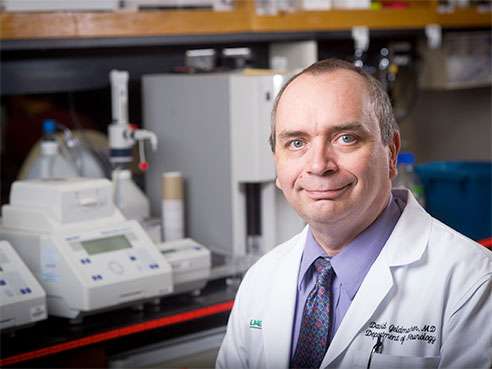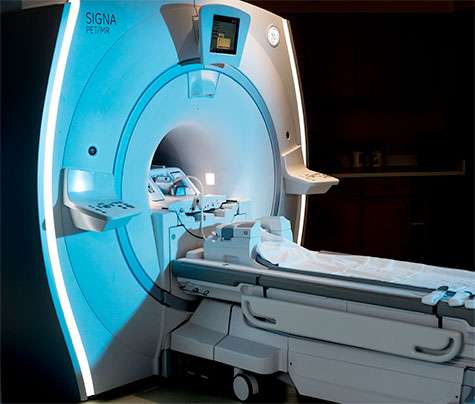Focus on Alzheimer's disease shifts to prevention

It has been 111 years since Auguste D. became the first person described with what is now called Alzheimer's disease. German psychiatrist Alois Alzheimer, for whom the disease is named, first publically reported his observations of Auguste in 1906, upon her death at age 56. Now, as life expectancy grows—there are 29 nations with an average life expectancy of 80 years of age or older—the specter of Alzheimer's disease looms larger than ever.
"In my experience, Alzheimer's disease is the most feared disease in people over 65," said David Geldmacher, M.D., the director of the Division of Memory Disorders in the Department of Neurology at the University of Alabama at Birmingham. "And while it's true that efforts to find a cure for AD have not yet proved successful, much of that fear may be misplaced, since we have learned so much about the disease in the last several decades."
So much so that Geldmacher says prevention, not cure, may be the key to stopping Alzheimer's.
"When I started my career treating dementia, Alzheimer's was a black box that we couldn't open," he said. "We couldn't even diagnose the disease except with an autopsy after death. We couldn't treat it or slow its progression, or stop it in the first place. Today we have a much better understanding of Alzheimer's and are much closer to developing meaningful therapies that will be beneficial in prevention and treatment."
Geldmacher, who was recently named the Warren Family Endowed Chair in Neurology in the UAB School of Medicine, likens the process to how medicine overcame earlier scourges such as pneumonia.
"First we had to discover germ theory, then isolate the bacteria responsible for pneumonia, develop antibiotics to kill the bacteria and then ultimately develop a vaccine to prevent the disease in the first place," he said. "That took about 100 years. We are following the same pathway of knowledge with Alzheimer's, but now with much better tools."
One of those tools is the PET scan, or positive emission tomography. PET scans use radioactive tracers that can bind to substances in the body and then light up during the scan, producing images that show increased brain activity.
In Alzheimer's, advanced imaging facilities such as UAB use a special tracer that binds to a brain protein called amyloid beta. Amyloid is routinely produced in the brain, but an abnormal increase or buildup of amyloid is toxic, and a hallmark of Alzheimer's.
"We can now use PET imaging to look at the brain of a person without any symptoms of memory loss or dementia, and see if a buildup of amyloid is already occurring," Geldmacher said. "This doesn't tell us when symptoms of dementia might start, but does indicate an increased risk for Alzheimer's at some point in the future. More importantly, it gives us a target for aggressive efforts to reduce the amount of amyloid and hopefully reduce the risk."
UAB is actively involved in several clinical trials aimed at reducing amyloid levels in the brain, including the A4 study, a national trial with 66 investigational sites. Participants will undergo PET imaging to search for amyloid buildup. Those with significant amyloid will receive a drug called solanezemab, delivered via infusion, which binds to amyloid protein and helps the body dispose of it.
A second trial, called EARLY and coming in 2017, is for an oral medication that is thought to inhibit the production of amyloid, reducing its level in the brain.

The DIAN-TU study is looking at a version of early-onset Alzheimer's called dominantly inherited Alzheimer's disease, a more rare disease type caused by a genetic mutation.
"This study, conducted in younger individuals who are at genetic risk of the disease because of a parent with Alzheimer's due to one of these mutations, is testing two monoclonal antibodies designed to reduce amyloid," said Erik Roberson, M.D., Ph.D., the Patsy W. and Charles A. Collat Professor of Neuroscience, and primary investigator at UAB for the trial. "While there are some differences between this type of early-onset disease and the more common age-associated disease, we believe the results will have implications for future studies and treatments for all types of Alzheimer's."
Another trial, called EMERGE, is a Phase III study assessing a drug called aducanumab for Alzheimer's. Results of a prior study of aducanumab indicated that it had a dose response curve, meaning higher doses showed better responses. The EMERGE trial is recruiting patients with a condition referred to as mild cognitive impairment.
"Now that we can use PET imaging to predict the likelihood of Alzheimer's, we've changed how we characterize the disease," Roberson said. "We used to consider mild cognitive impairment to be a precursor of Alzheimer's. Now we look upon it as part of the disease, simply an early stage. For prevention strategies to work, we have to consider the first sign of amyloid buildup—before symptoms emerge—as the starting point of Alzheimer's disease."
Even though Geldmacher and Roberson are excited about the prospects of prevention, both understand that better therapies for those who already have the disease are needed, as are better ways to help families and caregivers manage the complexity of coping with an Alzheimer's patient.
"We can't reverse dementia once it has begun, and we can't induce the body to make more neurons after brain cells are lost," Roberson said. "We have to find ways to ease symptoms and provide a better quality of life."
One method is using an individual's own genetic makeup to predict and determine which medications on the market will work best to manage an individual's particular symptoms. The Memory Disorders Division is working closely with UAB's Hugh Kaul Personalized Medicine Institute to utilize the power of precision medicine in this effort.
A Department of Defense study, done in collaboration with Rita Jablonski-Jaudon, Ph.D., an associate professor in the UAB School of Nursing, is using telemedicine for personalized caregiver coaching on how to respond to disruptive behaviors, reducing caregiver stress and improving the home environment. The project, which may also have utility for patients with traumatic brain injury, uses face-to-face coaching via the internet.
Geldmacher also directs the UAB Alzheimer's Risk Assessment and Intervention Clinic, the first such clinical service in the nation. Patients receive a detailed, personalized risk assessment, which includes family history, a detailed memory history for the patient, cognitive testing and a baseline MRI scan. That information is incorporated into existing risk-predictor models, which have been validated by research studies that followed thousands of patients for as many as 20 years to produce an accurate risk assessment.
"We focus on the reversible risk factors," Geldmacher said. "So many people facing dementia focus on the irreversible risk factors, such as 'I'm getting older' or 'my dad or mom had dementia.' We can't change those things, but we can change things like levels of physical activity and cholesterol counts and blood-pressure numbers."
He says the studies have shown that reducing one or more risk factors can have a significant effect on reducing one's overall chances of developing Alzheimer's disease.
"I am more optimistic that we will find ways to prevent and treat Alzheimer's disease now than when I started in the field," Geldmacher said. "The Risk Clinic, pre-symptomatic diagnosis, imaging gains—all of these advances have given us new targets for investigation. During my career, we have sequenced the amyloid peptide, and we have discovered the genes that might modify and regulate it. Most importantly, we have developed an understanding of the factors underour control that we can use now to modify the risk for developing Alzheimer's disease."




















